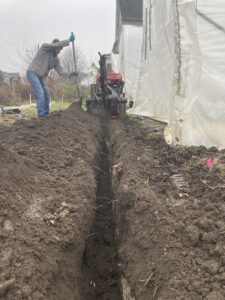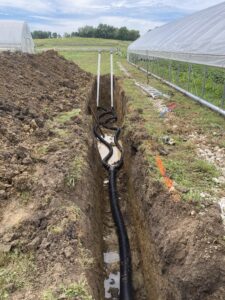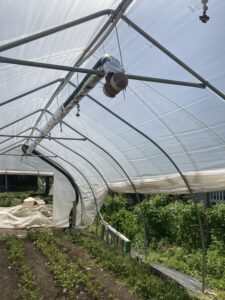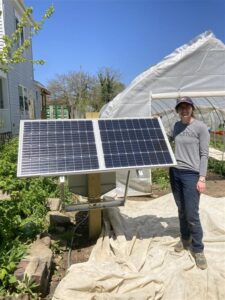Final report for GNC23-378
Project Information
Title: Utilizing Shallow Geothermal Resources for Low-Cost Season Extension of Controlled Environmental Agriculture: Performance Evaluation and Design Tool Development
Context: Season extension using high tunnels is a formidable tool for growers, allowing them to grow, harvest, and sell produce during an extended time period at a higher price point, providing economic sustainability. Unfortunately, heating and cooling high tunnels can be energy-intensive and costly, so finding lower-energy alternatives could offer financial benefits to farmers and decrease their reliance on fossil fuels. Just 1-2 m underground, the soil is cooler than ambient air in the summer, and warmer from fall through spring. An earth-to-air heat exchange (EAHX) system utilizes these shallow geothermal resources as air pulled through the system will gain heat from or lose heat to the soil, depending on the season. My previous project has shown EAHX systems can be installed on-farm for a low cost (comparable to a propane heater) and provide supplemental heating and cooling. It is desirable to investigate the heating and cooling provided by a standalone EAHX system compared to a passive high tunnel, and to apply these findings into an extension-ready tool for more farmers to adopt sustainable season extension infrastructure.
Approach: An on-farm research study will be performed comparing the growing conditions of two side-by-side high tunnels - one which only uses passive ventilation fans and roll-up sides, and another additionally outfitted with an EAHX system. Local weather conditions, soil temperatures alongside the EAHX, and air temperature and relative humidity in both high tunnels will be monitored. Additional soil temperature monitoring will investigate the seasonal temperature changes under different land covers that are relevant to high tunnels in urban agricultural applications.
Outcomes: Through this project, an on-farm shallow geothermal EAHX system will be installed and demonstrated through field days and conferences. Additionally, a user-friendly design tool will be developed to show the thermal and cooling capabilities and costs of EAHX systems based on the comparison of a passive and EAHX-aided high tunnel and the seasonal soil temperatures under urban landcovers adjacent to high tunnels. These findings and training in the decision-making tool will be disseminated through OSU Extension and farmer’s organizations. Research outcomes will also be disseminated through publication of fact sheets and journal articles.
Evaluation: Post-impact assessments will be collected during field days, conference presentations, and design tool workshops. Additional follow-up of workshop attendees will investigate if any farmers have adopted this technology.
Learning outcomes: Farmers will learn about a sustainable tool for low-energy season extension. They will be able to use a decision-making tool to estimate economic and environmental costs and benefits of different heating and cooling techniques for high tunnels. Through workshops, conference presentations, and field days, farmers will learn the principles of how shallow geothermal resources can be used to provide seasonal heating and cooling. The background research into seasonal soil temperatures under different land covers will ensure wider applicability to different configurations of EAHX systems in urban and rural high tunnels.
Action outcomes: Equipped with a greater understanding of EAHX systems and their costs and benefits, farmers will adopt a low-energy season extension infrastructure as a supplementary or stand-alone heating and cooling system. This will in turn increase their profits and reduce their energy costs and reliance on fossil fuels or inefficient passive high tunnels. These outcomes will be assessed through post-impact surveys and six-month follow-up surveys of all farmers participating in design tool workshops, field days, and conference presentations.
Research
System Design:
At two sites with different tunnel sizes (one 30'x96' high tunnel and one 15'x40' caterpillar tunnel), EAHX systems were designed to provide airflow through the system at approximately 0.5 air changes per hour (ACH) using design equations to account for thermodynamics of heat exchangers and the pressure lost through the system. The systems used a mix of corrugated and smooth pipe in widely available 4" and 6" diameters.
System Install:
Before excavation, 811 was called to verify no buried utilities in the area. At the urban farm site, a walk-behind trencher was used to excavate the trench, and it was found that the nominal 4' depth was only able to consistently excavate to 2.5-3'. The total underground run of the system was about 64', and the system was installed with a sloped bottom to allow a pump-out point, and included an inlet cover to protect the system from moisture and pest intrusion. A student team helped to size and select an appropriate solar PV and battery system to power the DC fan used at the site and installed the PV system adjacent to the tunnel. The output of the EAHX was placed in the center of the caterpillar tunnel, and the distribution ductwork was wrapped in insulation.
At the rural site, a backhoe was used to excavate a 6' deep trench, and the buried geothermal ducting included a branched design with two runs of approximately 40' of 4" corrugated piping and two inlets, connected to a 6" corrugated pipe to the rest of the tunnel. The excavation work was completed in fall 2024 but final electrification of the system has not been completed at this point. The air distribution for this system will likely use horizontal airflow fans to distribute the outputs of the EAHX.
System Monitoring:
At the two sites, data logging sensors were installed throughout both experimental (EAHX-equipped) and adjacent control (no heating or ventilation infrastructure) tunnels, monitoring the temperature conditions at 4" soil depth and 8" above the soil surface at multiple points throughout the tunnels. Sensors were also installed in the EAHX systems, monitoring the temperature and humidity of air at the intake and exit of the systems.
Though monitoring sensors have been installed at the two EAHX systems and their co-located control tunnels, funding and personnel challenges for nonprofit producer partners has caused some challenges in full electrification and utilization of these systems.
Still, valuable insights have been gained into adapting these systems to unique constraints presented at the partner farms. Figure 1 below shows the use of a walk-behind trencher that was used to install the system at our urban farm partner. It was nice to use equipment that was smaller and less damaging to the adjacent in-ground plots. We did run into some challenges using the trencher, as we found it was not able to consistently dig to the rated depth. We also ran into an old building foundation on our urban site, so we would recommend to look at other resources and records beyond calling 811 before doing these types of excavations.

To enhance the heat exchange capacity of our geothermal systems without excavating a larger area, we installed a new design that included a section of smaller diameter pipes. Using smaller diameter tubes lowers costs and means a higher surface-area-to-volume ratio, allowing more of the air comes into contact with the sides for conductive and convective heat transfer. Figure 2 below shows the Y connection in the trench, to bring two 4" corrugated pipes together with a 6" corrugated pipe to transfer the air the rest of the way into the tunnel. Besides the 4-4-6 wye which had to be specially ordered, the rest of the components were standardized sizes from local hardware stores.

Something we learned from previous geothermal system installations is that we should insulate the piping after it comes out of the ground so we minimize any loss of the heating or cooling capacity we gained from the underground system. Figure 3 below shows the distribution system we installed at our urban farm site, using foam and reflective-type insulation along the length of the aboveground portion. Our distribution system also had to direct airflow towards either end of the tunnel, and provide a barrier to exclude pests from the system.

Our urban farm partner operates on a few different parcels of land, and not all of them have electricity. The site where we located the geothermal heat exchange system didn't have power, so a registered student organization from the Ohio State University - Students for Sustainable & Resilient Communities - helped size, site, and install a solar panel and battery system to run the fan for the system, shown in Figure 4.

Educational & Outreach Activities
Participation Summary:
- Hosted a field day at partner farm Oaks and Sprouts Limited to demonstrate the pilot EAHX System. Developed a handout detailing background principles and installation tips.
- Gave talk to industry-academia working group Ohio Controlled Environmental Agriculture Consortium outlining results from pilot EAHX system
- Hosted a workshop primarily for farmers at 2024 Ohio Ecological Food and Farm Association with about 30+ attendees, detailing installation of EAHX systems and outcomes from pilot system
- Gave a conference talk primarily for agricultural professionals at 2024 Urban Food System Symposium, and submitted an accompanying article in the conference proceedings
- Gave a conference talk primarily for academics and researchers on EAHX pilot system outcomes, with a focus on Sustainable Energy Systems for Controlled Environment Agriculture for the 2024 American Society of Agricultural and Biological Engineers Annual International Meeting
Project Outcomes
This project explores the effectiveness and costs of an alternative to fossil-fuel powered heaters. By using shallow geothermal earth-to-air heat exchange systems, we hope to find that we can enhance the seasonal heating and cooling of high tunnel and caterpillar tunnel structures for our farmers, giving them an extended season for produce growing without using propane heaters.
Through this grant and others received from the Ohio State University that built on this project, we had a chance to learn more about building EAHX systems in 2 different on-farm contexts. Installing one shallow geothermal system in a rural area, we met challenges like running into buried clay pipe and the challenges of getting electricity to high tunnel built on farmland. With our urban partner farm, we also had electricity limitations which we were able to overcome with a standalone solar PV-battery system.
We have sensors in place in experimental (EAHX-equipped) and control (no heating/cooling infrastructure) tunnels and will continue to learn more about the outcomes these systems are able to deliver for our partners.